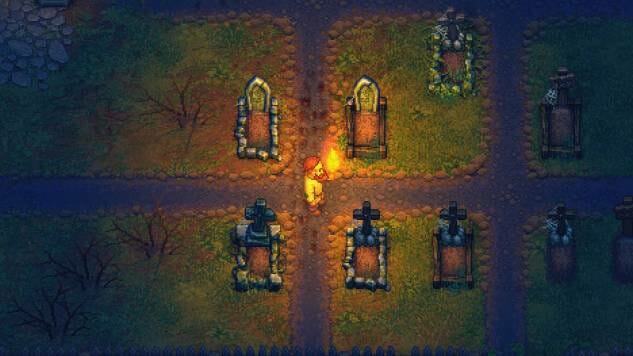I don’t know what compelled me to finally start playing Graveyard Keeper today. I’ve been receiving emails from their PR for what feels like years, and while it originally piqued my interest on name alone, since the game is only in alpha, I haven’t been in a real rush to get around to it.
Which brings me to now, only a few days after E3, as I’m winding down from an overstimulating week of interviews, meetings, presentations and demos. As the saying goes, “I’ll catch up on E3 when I get home from E3.” I still haven’t gone back and read all the headlines I missed while I was taking meetings to make headlines. In a streak of rebellion I find myself playing anything that sounds good and that I’m absolutely under no obligation to play. When you review games for a living, playing one that doesn’t net you much in terms of SEO or brand building is as close as you can get to playing a game recreationally anymore. It does a lot to reduce the pressure that comes from always feeling like you’re under a time constraint, but also creates a nice, clear little demarcation line between work and pleasure. It’s the only time I get to have fun playing a game.
In Graveyard Keeper, the titular character is crossing the street one night and gets hit by a car, awakening to find himself in the medieval era, tasked with cleaning up and rehabilitating the town’s cemetery. When he’s not quizzing the locals about his bizarre predicament or dumping bodies into one of the many holes he digs on church grounds, he also builds the items needed on his homestead to maintain a farm and gather resources from the terrain. The game, like Stardew Valley, balances this with the player’s stamina and health bars, and uses a calendar and weather cycle to dictate the working conditions each day and night. The goal is not only to clean up the graveyard, but figure out how to tap into whatever caused his mysterious journey in time and return to “his love”.

What does this have to do with Stardew Valley, exactly? It took a second for even me to understand why I was making the comparison, but it makes sense: both are resource management sims, which I like, and both let me plant things, although in Graveyard Keeper I’m often planting bodies, which I honestly like more. But the boredom and lack of direction I wound up feeling with Stardew Valley seems to be absent in Graveyard Keeper. There’s more structure to the process of teaching the player the systems, and the story is more intriguing and fully thought-out. I also vastly prefer how it looks; both are done in pixel art, but Graveyard Keeper is beautiful and the style is cohesive, whereas Stardew Valley feels like a mish mash hobbled together from pieces that are ultimately ill suited to one another.
Now, granted, the comparison might not hold up as well when it comes to the farming. The crafting, sure—there are lots of things to make, and the structure of succession is fair. But of course the crops aren’t as numerous and diverse as Stardew Valley. That being said, the farm life wasn’t always sweet in Stardew Valley, and while the community center sidequests gave it some sense of purpose, it falls apart without a lot of external, self-motivated energy on the part of the player. Graveyard Keeper also has its own stuff going on; I’ve got bodies to dissect and bury, headstones to make, and a bishop to impress, not to mention an ancient cult secret that, once unraveled, might send me back home.
A bad thing about alpha builds is the possibility that an update will wipe out your entire save file at any moment. I’m playing with fire in more ways than one. Be that as it may, Graveyard Keeper shows a lot of early potential that makes the risk worth it. If the urge to play a resource management sim hits me again any time soon, I know where I’m headed—and it ain’t Stardew Valley.
Holly Green is the assistant editor of Paste Games and a reporter and semiprofessional photographer. She is also the author of Fry Scores: An Unofficial Guide To Video Game Grub. You can find her work at Gamasutra, Polygon, Unwinnable, and other videogame news publications.
